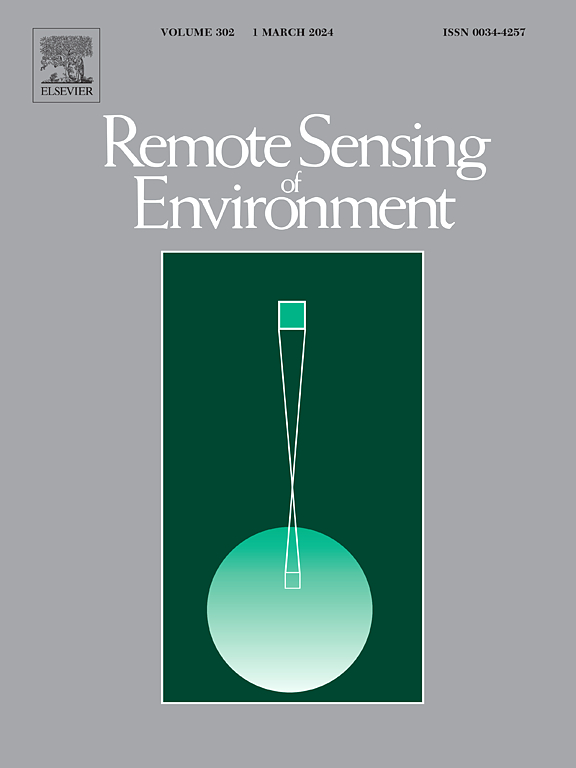GDCM: Generalized data completion model for satellite observations
IF 11.1
1区 地球科学
Q1 ENVIRONMENTAL SCIENCES
引用次数: 0
Abstract
Ocean remote sensing data is crucial in understanding the global climate system. Due to satellite orbital coverage gaps and cloud cover, satellite ocean remote sensing products have significant data gaps. This paper introduces a Generalized Data Completion Model (GDCM) based on deep learning to reconstruct gap-free and cloud-free key oceanic variables such as sea surface temperature (SST), wind speed, water vapor, cloud liquid water, and precipitation rate derived from polar-orbiting satellite sensors including Advanced Microwave Scanning Radiometer 2 (AMSR2), the Special Sensor Microwave Imager (SSMI), and the Moderate Resolution Imaging Spectroradiometer (MODIS). Utilizing Convolutional Neural Networks (CNNs) and attention mechanisms, the GDCM model effectively leverages spatio-temporal information within remote sensing data to fill in missing regions accurately. We use reanalysis data to simulate various data missing scenarios during model training for model development. We tested the model with the US East Coast region's global-coverage AMSR2/SSMI and local-coverage MODIS datasets. The experiments demonstrate that the GDCM model successfully and precisely completes the data for different satellites and types of missing data. To enable the model to capture enough data for the dynamical change patterns, we used seven consecutive days of observation data as inputs to improve the model's data-completion ability, significantly enhancing the handling of MODIS SST missing data due to cloud cover. When the input data's duration increased from one day to seven days, the model's R2 value improved from 0.062 to 0.93, and the Root Mean Square Difference (RMSD) decreased from 6.58 to 0.92. Besides the model framework design, we implemented the incremental learning training strategy to enhance the model's data completion capability for different types of missing data, especially for SST data from AMSR2 satellites. The model's completed SST data R2 value improved from 0.93 to 0.99, and the RMSD decreased from 2.64 °C to 0.50 °C. The Mean Absolute Difference (MAD) of water vapor data decreased from 0.88 kg/m2 to 0.76 kg/m2, and the RMSD decreased from 1.39 kg/m2 to 1.27 kg/m2. This study provides a generalized new solution to the problem of missing ocean data at different resolutions, contributing to a more comprehensive and supporting ocean science research and related applications.
GDCM:卫星观测的广义数据补全模型
海洋遥感数据对于了解全球气候系统至关重要。由于卫星轨道覆盖缺口和云层覆盖,卫星海洋遥感产品存在严重的数据缺口。本文介绍了一种基于深度学习的广义数据补全模型(GDCM),用于重建来自极轨卫星传感器(包括高级微波扫描辐射计 2(AMSR2)、特殊传感器微波成像仪(SSMI)和中分辨率成像分光仪(MODIS))的无间隙、无云的关键海洋变量,如海面温度(SST)、风速、水蒸气、云液水和降水率。利用卷积神经网络(CNN)和注意力机制,GDCM 模型能有效利用遥感数据中的时空信息,准确填补缺失区域。在模型开发的模型训练过程中,我们使用再分析数据模拟了各种数据缺失情况。我们使用美国东海岸地区的全球覆盖 AMSR2/SSMI 数据集和本地覆盖 MODIS 数据集对该模型进行了测试。实验证明,GDCM 模型能够成功、精确地补全不同卫星和不同类型的缺失数据。为了使模型能够捕捉到足够的动态变化模式数据,我们使用了连续七天的观测数据作为输入,以提高模型的数据补全能力,显著增强了对因云层覆盖而缺失的 MODIS SST 数据的处理能力。当输入数据的时间从一天增加到七天时,模型的 R2 值从 0.062 提高到 0.93,均方根差(RMSD)从 6.58 减小到 0.92。除了模型框架设计外,我们还实施了增量学习训练策略,以提高模型对不同类型缺失数据的数据补全能力,尤其是对 AMSR2 卫星的 SST 数据的补全能力。模型完成的 SST 数据 R2 值从 0.93 提高到 0.99,RMSD 从 2.64 ℃ 下降到 0.50 ℃。水汽数据的平均绝对差值(MAD)从 0.88 kg/m2 降至 0.76 kg/m2,RMSD 从 1.39 kg/m2 降至 1.27 kg/m2。这项研究为解决不同分辨率下海洋数据缺失问题提供了一种通用的新方案,有助于更全面地支持海洋科学研究和相关应用。
本文章由计算机程序翻译,如有差异,请以英文原文为准。
求助全文
约1分钟内获得全文
求助全文
来源期刊

Remote Sensing of Environment
环境科学-成像科学与照相技术
CiteScore
25.10
自引率
8.90%
发文量
455
审稿时长
53 days
期刊介绍:
Remote Sensing of Environment (RSE) serves the Earth observation community by disseminating results on the theory, science, applications, and technology that contribute to advancing the field of remote sensing. With a thoroughly interdisciplinary approach, RSE encompasses terrestrial, oceanic, and atmospheric sensing.
The journal emphasizes biophysical and quantitative approaches to remote sensing at local to global scales, covering a diverse range of applications and techniques.
RSE serves as a vital platform for the exchange of knowledge and advancements in the dynamic field of remote sensing.
 求助内容:
求助内容: 应助结果提醒方式:
应助结果提醒方式:


